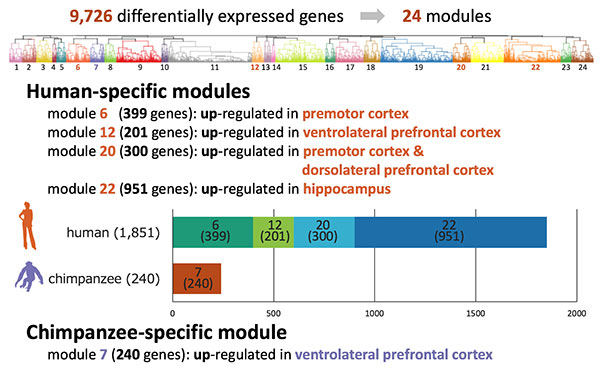Activities
- Home
- Activities
- Release
- The evolutionary trajectory of spatial transcriptome and epigenome in primate brains
Aug 6, 2018
The evolutionary trajectory of spatial transcriptome and epigenome in primate brains
Published in Genome Research
Molecular maps of the human brain alone do not inform us of the features unique to humans. Yet, the identification of these features is important for understanding both the evolution and nature of human cognition. Our member, Dr. Yasuhiro Go and his colleagues approached this question by analyzing gene expression and H3K27ac chromatin modification data collected in eight brain regions of humans, chimpanzees, gorillas, a gibbon, and macaques. An analysis of spatial transcriptome trajectories across eight brain regions in four primate species revealed 1851 genes showing human-specific transcriptome differences in one or multiple brain regions, in contrast to 240 chimpanzee-specific differences. More than half of these human-specific differences represented elevated expression of genes enriched in neuronal and astrocytic markers in the human hippocampus, whereas the rest were enriched in microglial markers and displayed human-specific expression in several frontal cortical regions and the cerebellum. An analysis of the predicted regulatory interactions driving these differences revealed the role of transcription factors in species-specific transcriptome changes, and epigenetic modifications were linked to spatial expression differences conserved across species.

Co-expression network analysis using 9726 differentially expressed genes (DEGs) showed 24 distinct modules and revealed four human-specific modules (module 6, 12, 20, 22) and a chimpanzee-specific module (module 7) in one or multiple brain region(s). A total number of genes classified into each module is more than seven times larger in humans than in chimpanzees (1851 genes in humans and 240 genes in chimpanzees).
Please visit the link below for further information.
Xu C, Li Q, Efimova O, He L, Tatsumoto S, Stepanova V, Oishi T, Udono T, Yamaguchi K, Shigenobu S, Kakita A, Nawa H, Khaitovich P*, Go Y.* (*Correspondence)
Human-specific features of spatial gene expression and regulation in eight brain regions.
Genome Research 28: 1097-1110.
